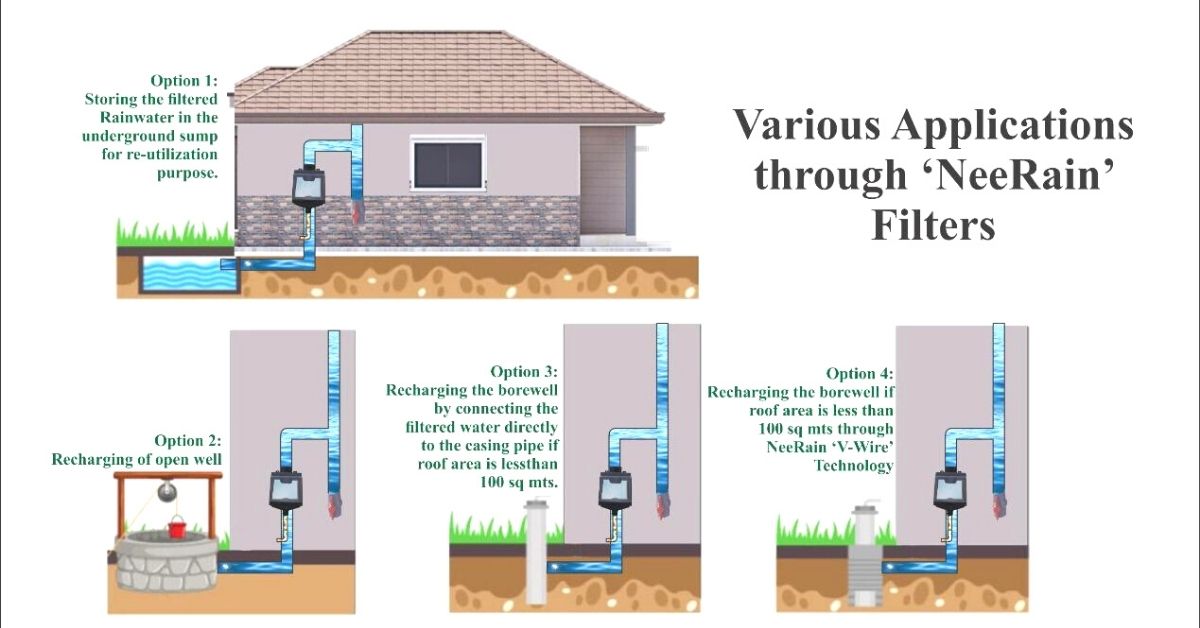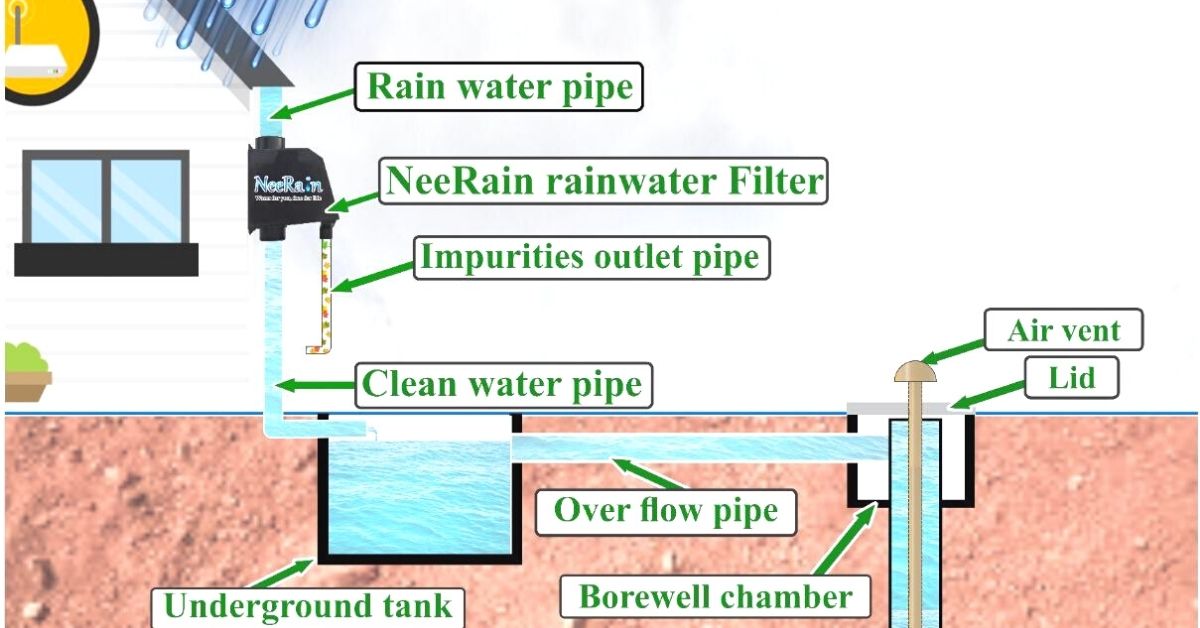In 2017, Amit Doshi from Gandhinagar, Gujarat, quit his corporate job in waste management after a 17-year-long stint, to start afresh. He says that while he wanted to continue working in the environment sector, he did not wish to follow the same line. He began exploring options.
After a few months of research in various fields of the environment, he decided to work towards rainwater harvesting. The 43-year-old tells The Better India that the decision came after understanding a series of issues related to rainwater harvesting systems and their functionality.
“The state and Central governments encourage water conservation and offer subsidies to install rainwater harvesting systems. Many people understand their importance as well. However, I learned that conventional systems were expensive and required space for the setup as they involved complex infrastructure such as the filtration system using gravels, as well as directing it towards the tank,” he explains.
Moreover, these systems incurred high maintenance costs and required a plumber or professional to address issues. “Many systems installed by private individuals were also found non-functional as they could not find the time or a professional to maintain it. Money also became a reason for people to avoid the maintenance,” Amit says.
He adds that in many cases, old construction buildings make it infeasible to install the system.
To bring a solution to all these issues, Amit built a maintenance-free and cost-effective two-stage rooftop rainwater harvesting system, NeeRain, under NeeRain Private Ltd. The device has been installed in over 1,000 households and exported abroad as well. It has contributed to harvesting about ten crore litres to date.
Making water conservation easy

Amit says, “Water is a fundamental resource, and everyone understands its value. Gujarat has witnessed heavy floods, during which this water washed away into drainage and rivers. Ironically, the same people facing floods experience water crises during the summer months and extract groundwater. Very few replenish it, resulting in millions of Indians suffering from water shortage. The crisis is worsening each year. The water does return to the ground where it comes from.”
He says that while many people wish to harvest water to build water security, the costs and complexity involved restrict them from taking the required steps.
He adds that after a year of research and development, the device was conceived and patented in 2018, aiming to empower individuals with a convenient solution and encourage them to contribute towards the environmental cause.
“A domestic help, gardener, child or anyone with a non-technical background can maintain the rainwater harvesting system. It is that simple,” says Amit, adding that simplicity was the sole intention behind making the system manageable and cost-effective.
Illustrating the device, Amit says, “The 1x1x1.5 foot device made from plastic fits on the wall of the house or building. It is attached to a pipe that receives rainwater from the rooftop and channelises it to the ground. NeeRain fits between the pipe as a bypass arrangement and has a two-stage filtration process.”
The filters vary in terms of the size of particles they net. “The first filter ensures that particles up to 500 microns are collected and allows water to pass through it. The water then collects in a small tank with a transparent cover which makes the process visible. The water then passes through the second filter that prevents the passage of particles up to 5 microns, which is the size of a hair. The water passes out of the system and is pure, clean and fresh rainwater. It exits to the borewell or groundwater source,” the entrepreneur says.

Amit adds that there are no leakages, and the filters are removable for cleaning. “It requires less plumbing costs and can be installed in a couple of hours as it only has to create a bypass in the existing pipe,” he says.
“Through this simple technique, a house or an entire colony can be made water secure. The cost of the plastic device is Rs 3,950, while the stainless steel is Rs 6,500. However, a traditional rainwater harvesting method costs between Rs 8,000 and Rs 10,000. The device becomes 40 to 60% cheaper,” Amit says.
He adds that a year of water collection from a 1,200 sq feet roof can recover the investment costs with respect to water bills. “The area will harvest about 60,000 litres of water in a place like Ahmedabad where the average annual rainfall is about 800 mm and potentially one lakh litres if the rainfall is 1,000 mm. No operations cost is involved in the exercise,” he says.
Amit says that over 1,000 individuals across the country and 200 in North America have benefited from it.
‘Put every drop of rainwater in the ground’
Vishukumar Shetty, a software professional from Bengaluru, says, “I installed the device in 2020 after I came to know about it on a Facebook group to prevent rainwater wastage. The house did have an old rainwater harvesting system but was non-functional. I did not want to spend money repairing the same as it required cleaning a big tank and involved a lot of filters to be changed.”
Vishukumar says that he could install the device with the help of a local plumber and that it is working efficiently. “The harvested rainwater is diverted to an open well in the premise, which is a smooth process. The device is easy to clean and portable, which would allow me to carry it along if I move base,” he adds.
Sai Prasad, a rainwater system dealer from Hyderabad, says, “I have tried multiple devices and used the product to check for its functioning. It is not disappointing in terms of efficiency and is cost-effective compared to other devices in the market.”
Amit says the devices collectively have saved about ten crore litres of water. “About 60% of the domestic beneficiaries have collectively saved around seven crore litres of water. The calculations are derived according to the surface area under harvest with the rainfall received in the region. The remaining contributions come from industrial and commercial installations which have larger surfaces and boast more water harvesting capacity,” he explains.
He adds that the company did not face any significant challenges apart from organising the finances. “I managed to seek a loan of Rs 10 lakh from the bank and invested another Rs 20 lakh through the business earnings for marketing, production and packaging,” Amit says, adding that it was also hard to create awareness and convince people to contribute to the rainwater conservation.
However, Amit believes that it is an important cause and requires consistent efforts. “The best quality filtered water arrives at the doorstep of every individual, and we must prevent it from going into drains. Every drop of water should go to the ground to ensure water security for the planet,” he adds.
Edited by Divya Sethu
No comments:
Post a Comment